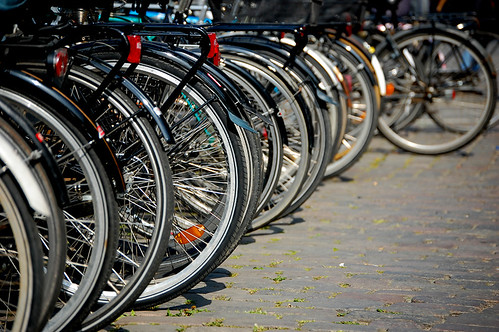
COPENHAGEN, DENMARK — I’ve been struggling for days to figure out where to start with my experience in Copenhagen.
Over the first few days I was being impressed by the hour, and sometimes by the minute. For instance, as soon as I got off the plane I hopped onto a train, for about $10 Cdn, that whisked me into the downtown in about 15 minutes (including two stops at other stations along the way). As I walked out of the main train station I was greeted by thousands of parked bikes. Wherever I walked, hundreds of cyclists passed by in separate, dedicated lanes. Riders and walkers got advance green lights at intersections. A plethora of parents carried their kids or groceries in cargo bikes. My hostel was a few feet from a thriving public square connected to one of 18 booming pedestrian malls. Bus-only lanes dropped people off at subway stations. The metro station designs were gorgeous. Modern architecture seemed to sit nicely, if not beautifully, between centuries-old row houses. The former industrialized waterfront was teeming with life, signature architecture and cultural institutions.
As a friend noted on the Wall of my Facebook profile, my status updates and Twitter feed were similar to how an 8-year old would react at Disneyland. And it’s kinda true: this city is like a Spacing-themed amusement park. With eyes wide open (and a camera pointing in every direction), I tried to absorb as much as I could.
Now, I know I shouldn’t paint the city with such a wide, positive brush after only 10 days of visiting, and I’m fully aware that Copenhagen has its share of problems like any large metropolis. But most of those glitches don’t seem to be of the urban design or planning nature.
So, instead of making long-winded opinionated posts, I’ve decided to publish postcard-like entries of examples of infrastructure, planning and urban design elements that caught my attention. Today I’ll start with cycling, because everything Copenhagen seems to do all comes back to the soft traffic of two (and often three) wheels. (please note there about 18 photos after the continue reading link).
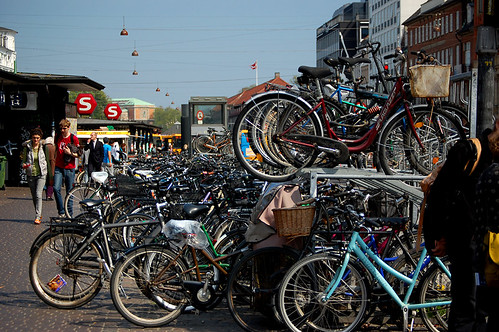
Thousands of parked bikes is impressive. But thousands of bikes parked outside of a subway station is even more spectacular. Its a symbol of integrated transportation, where riders have chosen to pragmatically split up their trip. At a few stations I even saw a room that stored bikes an escalator ride away from the platform.
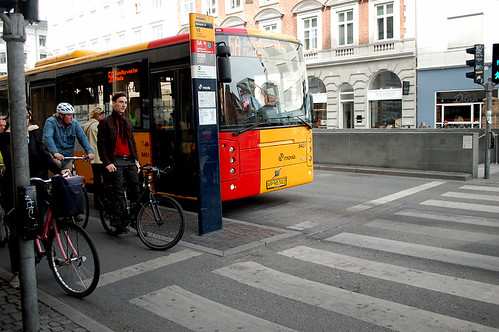
In many parts of the city, bikes and public transit went hand-in-hand. Transit stops often doubled as a buffer between buses and bikes helping create a totally separate lane for each.
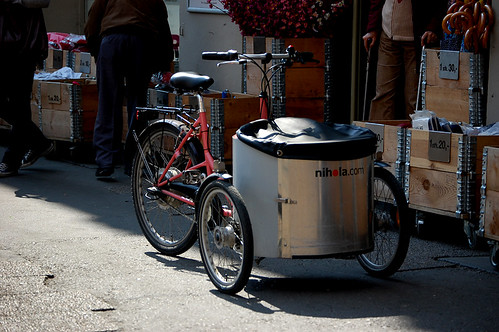

All over the city I saw riders using a variety of cargo bikes. Sometimes it was to transport kids, other times it was to move a large item. The city has a few styles in use, including the Christiania, Nihola, and the Bullitt.
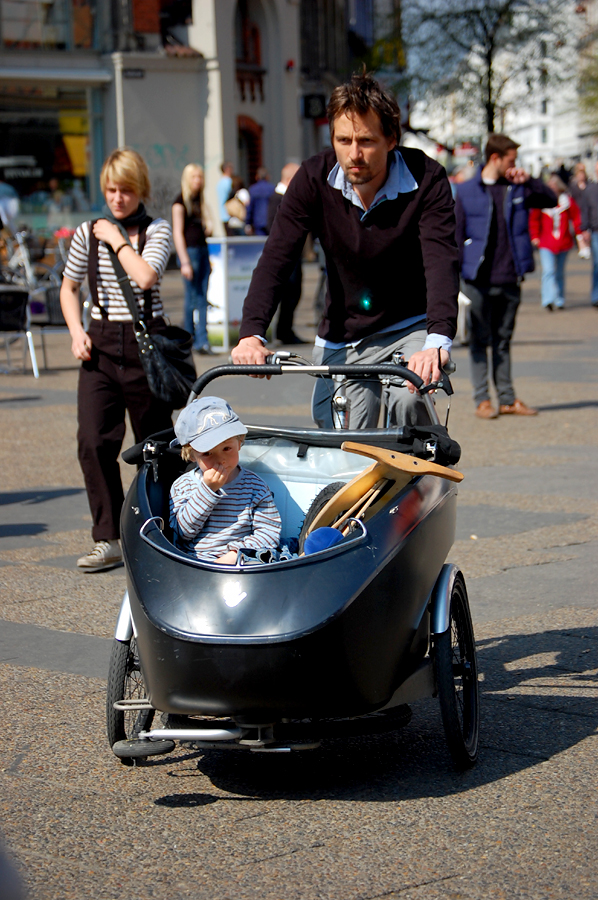

The Bullitt cargo bike is used by couriers, for the most part. The strong suspension design at the front allows heavy objects to be moved at speeds up to 40km/h. The bike is sold at a store called Larry vs. Harry, and the above photo is actually Harry (real name Hans). I ran into him on the waterfront where he was modelling the bike for a Japanese fashion magazine.
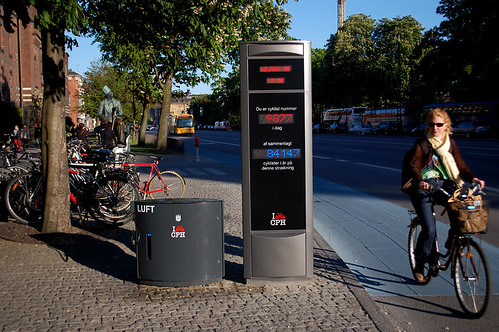
On May 1st, Copenhagen installed a bike counter at the intersection just outside City Hall. The top number (in red) is the date, the middle number (also in red) is how many cyclists passed through that day, and the bottom number (in blue) is how many cyclists have passed since the counter was installed two weeks ago. I’d love to see something like this in Toronto at an intersection known for high bike traffic (feel free to make suggestions).
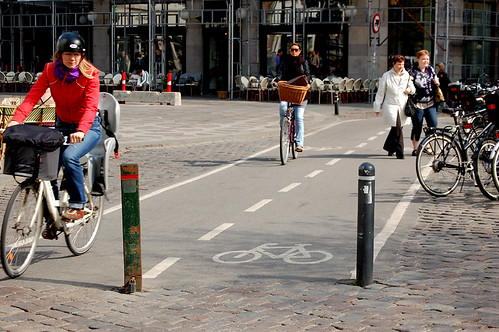
At numerous places where a public square, pedestrian mall/shared street, and bike lane intersect, attempts are made to indicate who goes where. This particular lane lead from a road with cars and a bike lane, through a square, and into a naked/shared street.
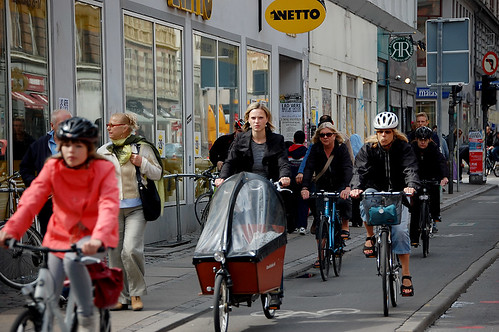
Many of the busiest roads with bike traffic have their own curbed lane, such as this example in the Norboro neighbourhood. These lanes are the first to be plowed during winter months since bikes are used more than motor vehicles or public transit on this corridor in and out of the downtown.
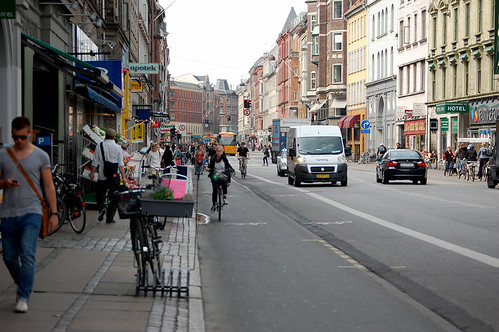
Check out the allocation of space on this right-of-way: pedestrians get about 3 metres, the bike lane is almost 4 metres, and cars get about 2.5 metres. This bike corridor is part of an experiment Copenhagen is trying out. Since cargo bikes are flourishing, there is a need for more space in the lanes. The City took away a lane of car traffic in each direction and added it to the bike lanes. The thinner, outside lane is now used by quicker riders and the wider lane is being called a “conversation lane” by local bike planners as it allows two cyclists to ride side-by-side and be social.
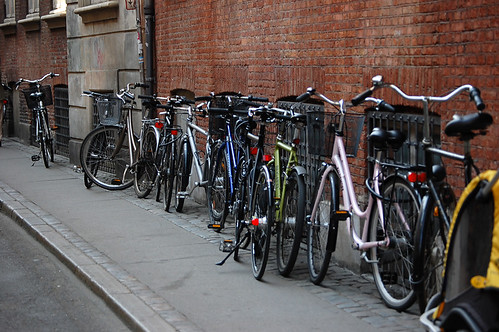
If Copenhagen has one problem with bikes it’s where to put them all. Bike parking is at a premium. In many places around the city, car parking has been replaced with bike racks (see below). Even more impressive is how little Copenhageners actually lock their bikes to anything. They use a lock installed near the bike tire and ignore the actual racks. The racks seem to just help keep things organized and the bikes balanced upright.
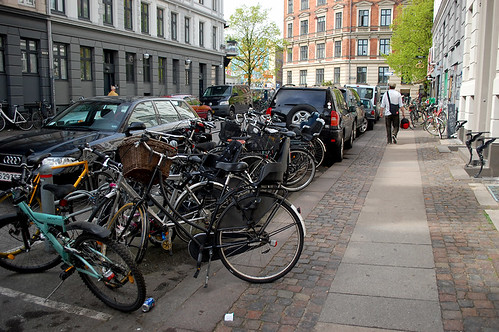

One of the more impressive pieces of bike infrastructure was the right- and left-turn lanes. When I came upon these examples it blew my mind.
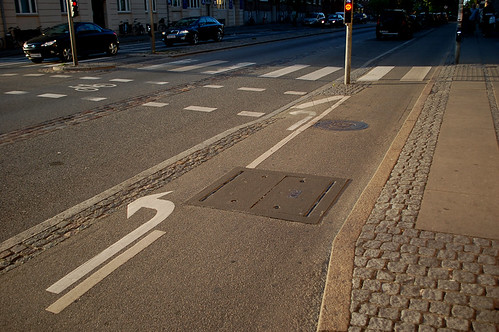


In the small, separate city of Fredericksburg (imagine the Annex being its own city in Toronto), green LED lights have been installed to indicate the bike lanes on this cobbled and dark street. While this might seem slightly gimmicky, I kinda like it.
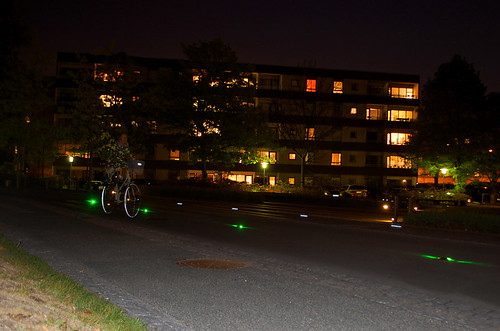
all photos by Matthew Blackett



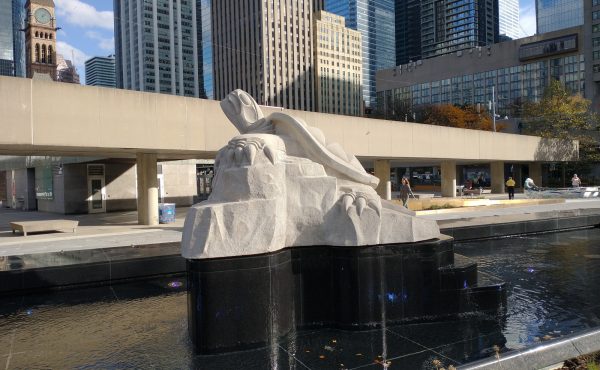
19 comments
I noticed in Oxford (UK) people also didn’t lock up their bikes. Just leaned them on buildings.
it is to weep….
This too could happen if we didn’t have a domestic automaker. What, a bail-out to keep them operating? $#*&!
It is wonderful! In my country, not so strongly developed “culture of the bike”
I travelled to Copenhagen 10 years ago. I remember the first day and the uphoric feeling that I felt about this city, with it’s pedestrian streets, bikes and the subway.
Thanks, Matt. This kind of reminds me of Beijing, where almost every major throughfare had bike-lanes on both sides, often as wide as one car lane, separated by greenery. And the thousands upon thousands of bikes parked together. That city had 17 million bikes by some stats. Of course, things are changing these days in China, automobile is steadily gaining upper hand over cyclist, and many young people forsake cycling as a symbol of lower-class. But still, the infrastructure there is beyond the wildest dream of cyclists here.
A very interesting summation. I dont think cars are the problem, its the mindset.
Here is an ongoing talk about car free cities in the NYT:
http://roomfordebate.blogs.nytimes.com/2009/05/12/carless-in-america/
This series just keeps making me sadder and sadder that I’m going to miss Jan Gehl’s lecture on the 3rd.
“I dont think cars are the problem, its the mindset.” Hmm… Even better explained, I don’t think that’d be a meaningful distinction.
Nice post – I’m liking this Scandinavian series a lot.
jamesmallon – Germany and Sweden have plenty of domestic auto manufacturing and yet have urban planning that’s almost as cycling-friendly as Copenhagen’s.
“In the small, separate city of Fredericksburg (imagine the Annex being its own city in Toronto), green LED lights have been installed to indicate the bike lanes on this cobbled and dark street. While this might seem slightly gimmicky, I kinda like it.”
I’ve always wanted to see more such minute everyday innovations in Toronto. In Switzerland, I’ve seen them used on highways through tunnels on lane markings, where red and white LEDs were used depending on the placement.
Many people don’t lock their bikes in Halifax, Nova Scotia (for an example of a place a little closer to home). Maybe we aren’t so far away from achieving the mindset/infrastructure as we think…
The photos of families and cargo bikes are really interesting. When I was single, I used to bike all the time for errands, to go to the gym, etc. Sure, I had to use a 30 lb motorcycle lock to protect my 15 yr old trek from NYC but it worked. One I had an infant I stopped biking. I could get what in North America passes for a baby seat, but besides the roads being pretty unsafe there is no way to haul those big packs of diapers or formula back from the store. And what if it rained? No more errands by bike.
In Copenhagen, it seems tossing the kid, diaper bag and some other stuff into the covered Christiania is not a problem. Awesome.
I wish Toronto would do something like this… we only seem to create narrow bike lanes right beside traffic. Fine for the Spacing crowd, but to get the elderly, women, children and many others out we’ll need to invest in separated lanes and better infrastructure.
I just don’t know if those generous separated lanes are feasible in Toronto. People often like to bring up the fact that Amsterdam and Copenhagen only achieved their bike-friendliness after years of work at the municipal levels, clawing back road and mind space from the car. But even at their post-50s low-point (somewhere in the early 70s, I think), those cities had mode shares that surpassed anything seen on this continent. We’re just too far gone to ever catch up.
That’s not to say there isn’t plenty of progress to be made here. I was riding the 95 York Mills bus today, and noticed that east of Bayview, there was a huge bit of lawn between the sidewalk and the road, on both sides. Perfect for a nice, generous lane, I thought. A quick check of the bike plan, and lo! and behold, that’s supposed to happen (eventually).
Reminds me very much of Holland, not just the big cities in the southwest but all over. It is indeed awesome stuff.
We’re not too far gone to do the same but it will take decades of serious planning. There are no shortcuts but at least we have their example to follow. If we look at the huge vehicle and gas tax imposed in Denmark we’d be on the right track.
When Peak Oil hits and almost nobody can afford to drive cars anymore (let alone buying and maintaining them) you’ll see how fast the infrastructure changes, and how many people suddenly (have to) use bikes for their transportation.
Unfortunately we have to wait a decade of two, and other problems (famine, heating) will negate the nice change.